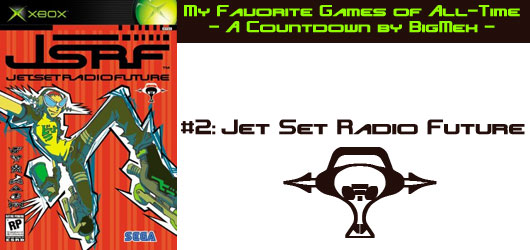
In all of 1UP there is one person who's jaw just hit the floor. I am certain that my pal Trevor was betting that this game would be #1 on the list. He knows that this game means a lot to me. It means an awful lot to me.
How much is a lot?
The rumors are true, I bought an Xbox for this game and only this game. I don't play other games on my system and I don't let my brothers play other games on my system. To me the Xbox was good for one thing, and that is for playing my number two favorite game of all-time.
Okay, so what makes this game so special?

Jet Set Radio Future is about a gang of "Rudies" called the GG's having fun, skating, dancing and putting up graffiti all over the fictional city of Tokyo-to. You start off the game as the newest recruit and have to complete various missions with or against other Rudies.
That's the game in a nutshell.
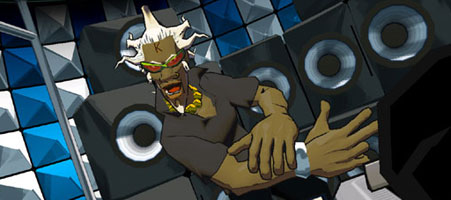
Jet Set Radio refers to a fictional radio station hosted by DJ Professor K. He's the person that provides the tunes as well as narrates the adventure portion of the game. DJ Professor K clues us in to a fierce rivalry happening between all of the Rudies in Tokyo. As the plot unfolds we learn that there is one person pulling the strings and vying for absolute power. His name is Gouji Rokkaku.
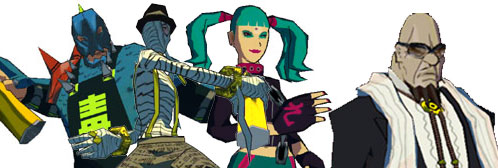
Gouji not only controls the militaristic police, he is also a mayoral candidate. He is rumored to have connections to the underworld crime ring known as the "Golden Rhinos." All of this plus the fact that he is creating wars between the Rudies is exposed by DJ Professor K. In doing so the GG's and Professor K are put on the police hit list.
This makes doing the graffiti and skating part all the more interesting as the game progresses.
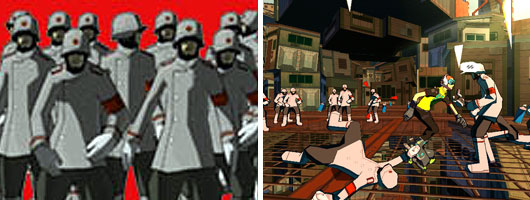
Police become more numerous the further in the game you get. Worse, they become tougher, from special forces to police in full riot gear. Eventually undercover agents, machine gun toting goons and even assassins from the Golden Rhinos join in the chase. By the end of the game the GG's have survived assaults from tanks, attack helicopters and even robotic spiders. All of this plus having a showdown with Gouji himself and his demons.
Demons?
Yes, it turns out that the Golden Rhinos are not only a mafia front, they are also part of Gouji's secretive cult. Gouji is not only ambitious but also quite mad with power. He plans on not settling for Tokyo or Japan. He wishes to rule the planet with his army of shadowy demons and power granted to him by our own fears. The design of his evil karmic machine is an opposite of Taro Okamoto's "
Tower of the Sun" from the 1970 Osaka World Expo. These details and more abound in the game.
I appreciated the work that went into every portion of JSRF, including little details like Gouji's infernal invention. The design by Smilebit doesn't just dump you into the world of tomorrow, it eases you in.
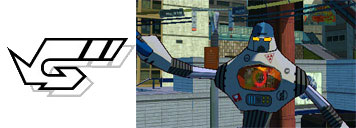
You are welcomed into the GG's by Roboy, a smack-talking robot member salvaged by Corn, the leader of the GG's. Roboy teaches you the basics of control and updates your library as the game progresses. It is the control that is king in this game. Despite having one of the better plots and some of the best character design in any videogame it would all be for show if the control didn't live up to the potential.
The city of Tokyo-to is massive and split up into multiple regions that are interconnected by a series or freeways or underground pipes. The load time between levels is minimal, perhaps a second or two at most. What makes the game great is the ability to explore each and every level without necessarily starting a mission. Yes it harkens to the open gameplay in GTA but it does so very subtly. One does not have to be a fan of the violence to appreciate this city. The perfect control in JSRF allows us to turn these streets, alleys and even sewers into one massive, interconnected playground.
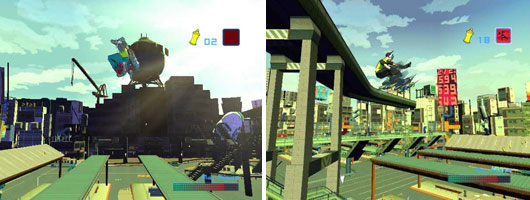
When I think of JSRF I think of massive air tricks and combos. These moves can all be done with the press of a few buttons. Jet Set Radio Future defies gravity in a way that no other action sports game can match. None of the Tony Hawk games, none of the SSX games and not even Top Skater or Air Trix by Sega. JSRF begat many of the things copied but never topped in the Hawk games. Besides the addition of a great plot in an action sports title (Dark Summit tried one for skiing and Tony Hawk's Underground for skateboarding) JSRF also introduced us to infinite combos, curved rails, massive wallrides, an immersive story, graffiti... well just read on!
Thanks to the rocket powered, magnetic skates, the characters in JSRF can not only grind along rails, they can also grind straight up, upside down and even through vertigo-inducing corckscrews without falling. Making their skates easily the best invention since Marty McFly's hoverboard from Back to the Future II.
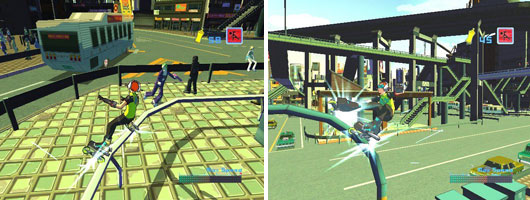
These skates also allow the GG's to do long wallrides and give the player a sense of freedom. If you see a billboard then chances are there is a way to reach it, wallride it and find new and hidden places to explore. Players can work wallrides into combos or use them to get away from rival Rudies and even the police.
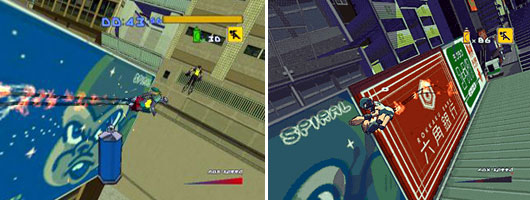
As if it wasn't cool enough that you could grind, jump and wallride all over Tokyo-to there was the added bonus of a "Boost Dash." If you collect enough spray paint in a level then you can activate this dash. With it you can tackle the toughest opponent or fly through a level at breakneck speed. I first saw the blur effect made popular in the GTA games while playing JSRF.
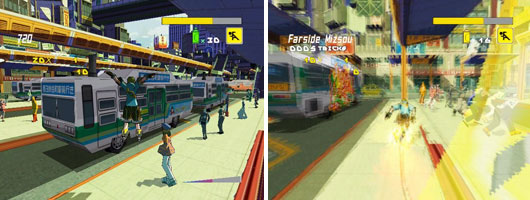
So what about the graffiti, the thing that defines this game? In JSRF you never have to stop to put up graffiti. Characters can skate by targets and spray away, automatically filling in patterns at different speeds depending on their ability with the can. At no point does the graffiti portion become sluggish or boring. Some tags require you to grind straight up a rail or even during the middle of a death defying leap. Each character brings their own interchangeable graffiti into the mix. There are "graffiti souls" all over the city that unlock new tags. Even with all that already in the game, budding artists can create their own graffiti with a built-in editor.
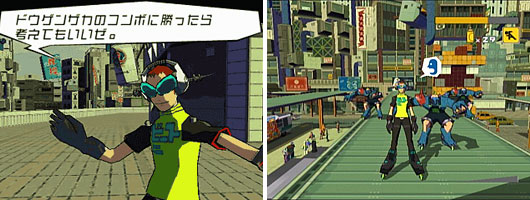
Characters talk with you, taunt you or challenge you. Even if you feel outnumbered there are still other GG's that you can recruit to help round out your crew. This game is the best example of diversity I could ever name. All of the characters in the game are well rounded. They represent the archetypes, strata and personalities that we come across everyday. All of the Rudies, heroes, villains and rivals are people that you either admire or despise.
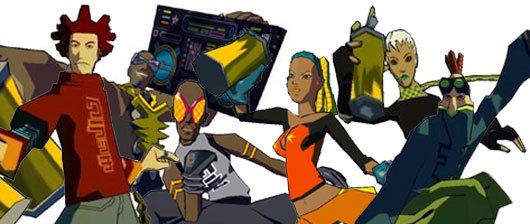
These people define society, the game defines Hip Hop. I don't mean the angry, commercialized "hip hop" on MTV or in Marc Ecko's Getting Up. I mean true Hip Hop in every sense of the word. True Hip Hop has four elements, graffiti, b-boy (breakdance), MC and DJ. None of these elements is more important than the others. Society chooses to label Hip Hop under the rap label, rather than the other way around.
Although the game was made entirely in Japan, set in the future and filled with a techno soundtrack, Smilebit hit the nail on the head when it came to Hip Hop. All of the four elements are in the game, DJ Professor K acts as both the DJ and MC. He is the voice of the street, providing some great music and sage advice to all of the Rudies listening into his pirate radio broadcast. All of the Rudies; the GG's, Rapid-99, Noise Tanks, Poison Jam, Immortals, Love Shockers and the Doom Riders can dance and put up graffiti, they represent the b-boy and graffiti pillars of Hip Hop.
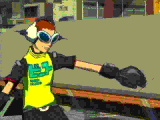
These groups of people, even the bad Rudies, are all struggling against Gouji Rokkaku. By the end of the game Gouji has become mayor and is really cracking down on all personal freedom, not just the kids with the skates. It is then that the game becomes a play on freedom of expression, the battle between right and wrong. JSRF does so masterfully and subtly at the same time. At no point does the game ever become too preachy or too heavy-handed. Everything is handled with a light, animated flavor. I hope Marc Ecko is taking notes!

Best of all, the message is wrapped within a very fun game. A game that takes at least a dozen hours to complete, even longer if you want to unlock all of the secrets. A game with some of the most fun levels ever imagined. Levels with roller-coaster tracks, skyscrapers, dinosaurs(!) and even a flying saucer... damn this game has everything!
Right when you think you've seen it all you begin to pick up the details. Each level, each environment is layered with details. People react to the skaters and even their reflections in the store windows. You can go through some open-air markets, knock over displays and cause havoc.

There is a reason for everything in the game, provided you look for it. The Rudies knock over the food stands because they charge outrageously high prices for food that they claim is healthy but is in fact not, the chemicals in the sewers have caused a giant salamander mutation, the number one hit in the music store is Blue Sky by a popular folk group and a bath house on 99th Street offers a special, seasonal, fruit punch bath. You'd know this stuff if you translated the Japanese page.
The game goes on and on with the details. Best of all you can share the experience with up to three other players in one of the multiplayer game modes.
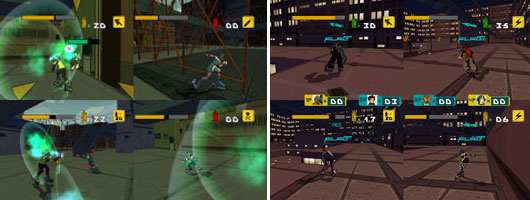
The game wraps up with one of the most mind-bending levels ever conceived. I don't want to give it away but Gouji really is out of his mind. Tokyo is turned upside down in some sort of parallel dimension, if you are prone to motion sickness or vertigo then the final level may very well make you sick. Heck, the final level is so twisted that the wild machines Gouji sends after you (usually piloted by Captain Hayashi of the Rokkaku P.D.) are tame by comparison.

This game became a cult hit. It brought out the extremes in gamers, either you liked it or you didn't. A real hit or miss and in the industry you need a title that appeals to everyone. That's why Sega never followed-up with any more JSR games. I think this game was too far ahead of the curve. The things that it accomplished have yet to be reproduced by any single action sports title, let alone any action sports series.
Dang if this wasn't a perfect game, easily making it my second favorite game of all time.
But this goes without saying...
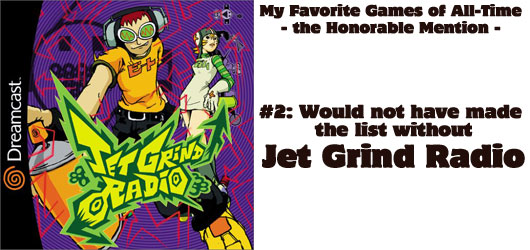
Jet Set Radio Future would never have existed without Jet Grind Radio (Jet Set Radio in Japan). The concept was simple, Smilebit wanted to create a skateboarding and graffiti game, yet they couldn't figure out how to get the player to run up and down stairs with a skateboard and still be able to spray. To solve the dilemma they changed it to inline skates and the rest as they say is history...
This Dreamcast game also stratified gamers, either you liked it or you didn't. There was no middle ground. JGR was the groundbreaking game from Smilebit. It set the bar that only JSRF could top.
Everything featured in JSRF appeared first in this game. The characters, the bad guys, levels and plot were all laid-out here. DJ Professor K still guided us, Tokyo-to was still being pulled apart by the Rudies and Gouji Rokkaku was still vying for power. Throw in the crazed Captain Onishima (inspired by Inspector Zenigata from the Lupin III anime) chasing around the GG's with the police, tanks and assault helicopters.

The design of the characters was groundbreaking. These were kids that looked like they came from a rave in Harajuku, the trendy spot in Japan. No other game features characters that could be doubles for those in JGR. The GG's have always hailed from Shibuya (another real-world trend spot) and have always fought the Rudies from Benten-cho and Kogane. JSRF expanded on these three areas in Tokyo and variations of each appear in the updated game.

There were some things that could be argued to be better in the original game. Variations on the plot, ending, the appearance of two US levels and some designs for characters did work better in the original. The ability to replay the story mode with an unlocked character was also unique to JGR. I would argue that the graffiti was better in the original game as well. I was so influenced by it that I recreated many of my favorite pieces in Illustrator with the hopes that someday I would be able to import them into a Tony Hawk game or perhaps another redux of JSR.

One thing that was equal in both games was the music. The work of musical director Hideki Naganuma was incredible. I'm not a fan of electronic music but his compositions were more than catchy, they were infectious. The indie acts that appeared on the soundtrack were also great, none more than
Guitar Vader. The sound for the JSR series was defined by Naganuma and Guitar Vader, they created aurally what Smilebit created visually, a style all their own and way ahead of the curve. Assuming you've never played either game I would still suggest checking out the albums which you can find on Amazon or eBay.
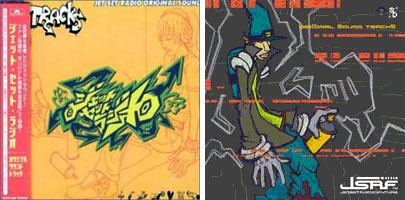
So there you have it, my number 2 most favorite game in the whole world and the game that inspired it (JSRF is not a sequel but a re-imagined game). It is easily a game that I could play forever and ever, it's just that damn good. So folks I hope you have a great weekend. Next week is the final week, what will number 1 be? I guess you'll have to wait a little longer! Peace.
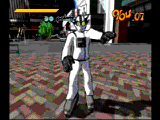
I’d like to hear your personal top-10, top-20, top fighting games, top sports games, or top games in any genre. Let me know in the comments section please. As always if you would like to sponsor me
please visit my Patreon page and consider donating each month, even as little as $1 would help make better blogs and even podcasts!
























Hi Noe, you should take a look to "Bomb Rush Cyberfunk" by Team Reptile which basically is a Jet Set Radio 3 with the addiction of skateboards, bikes, etc. It's out on every platform.
ReplyDeleteZero,
DeleteI've been keeping an eye on that game for years during development. I'm going to get it later this year for my birthday. Thanks for thinking of me when it was dropped.